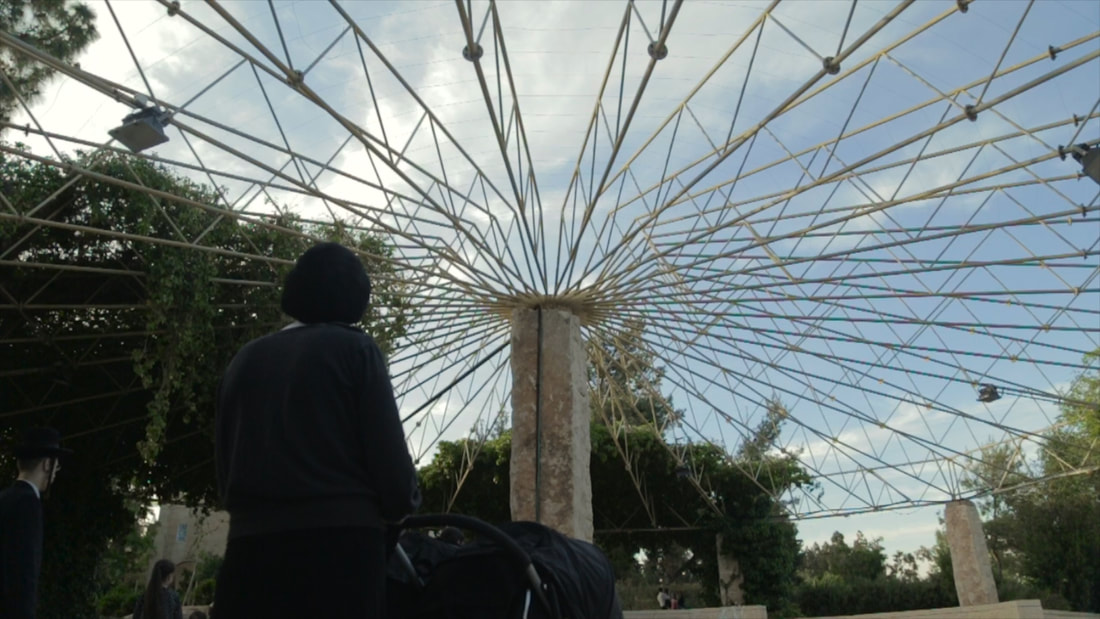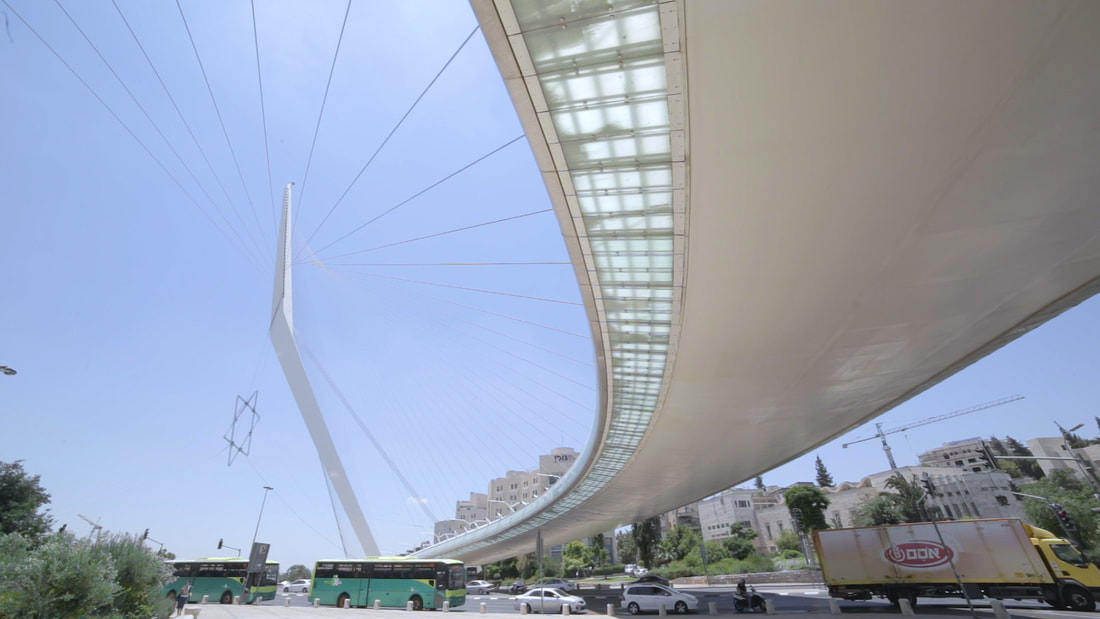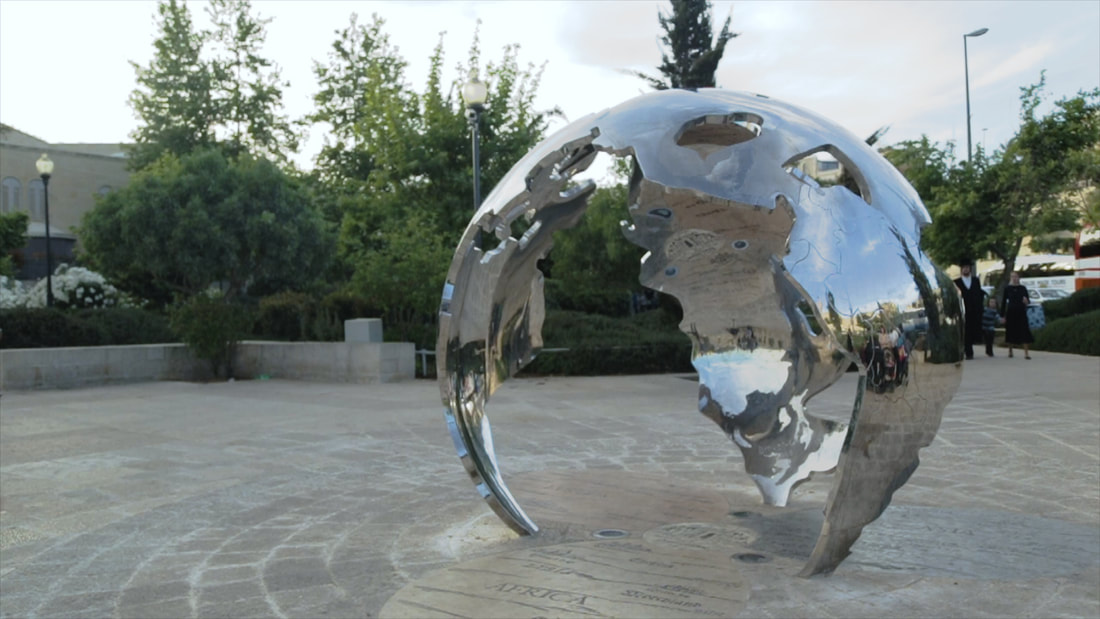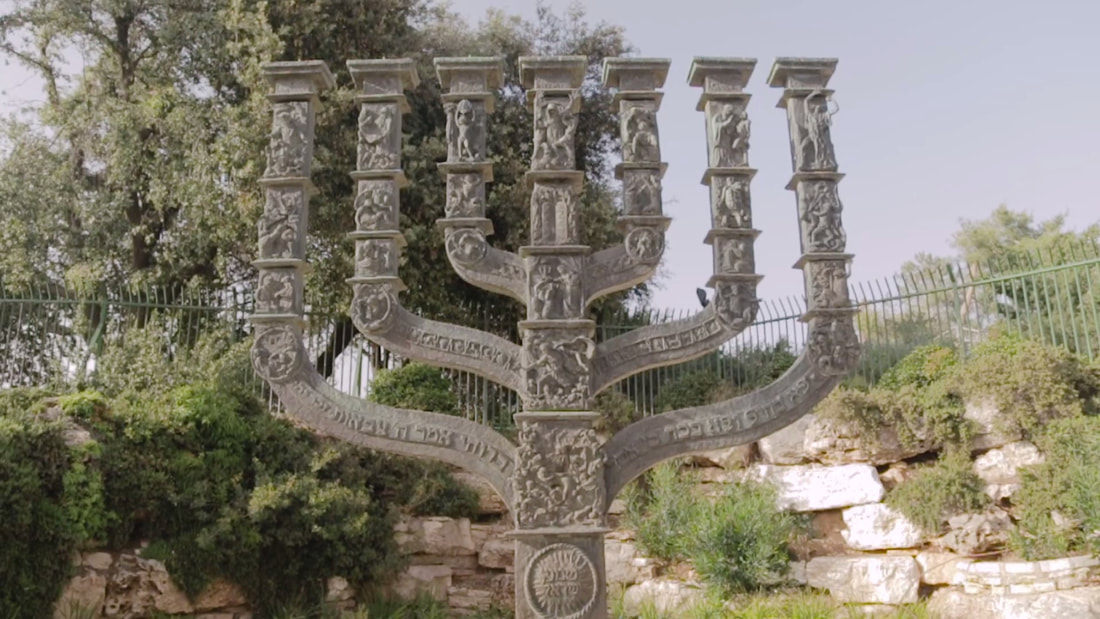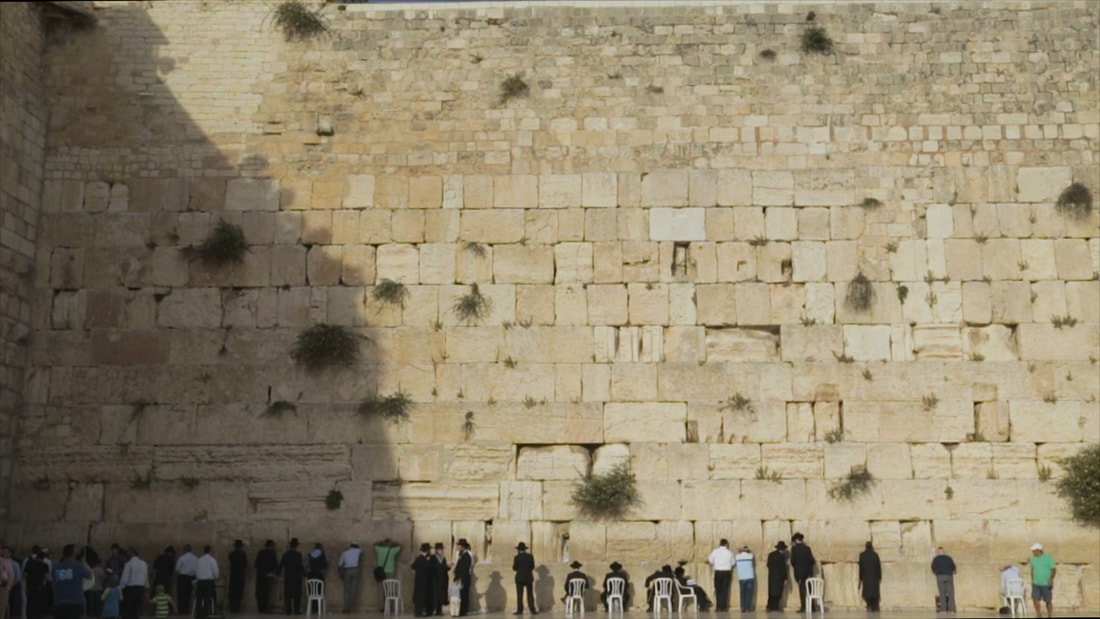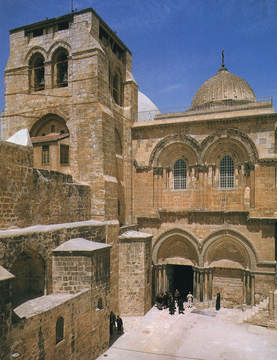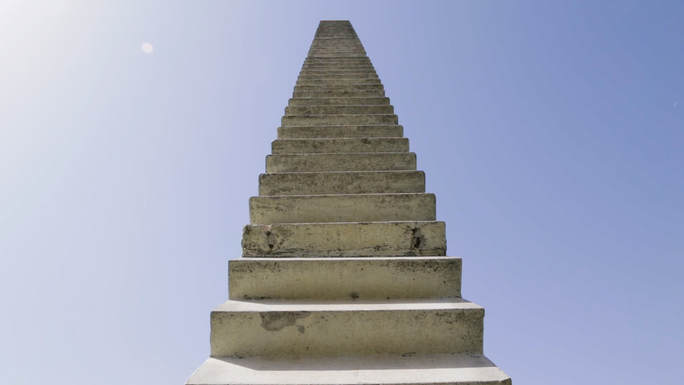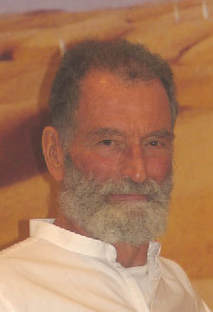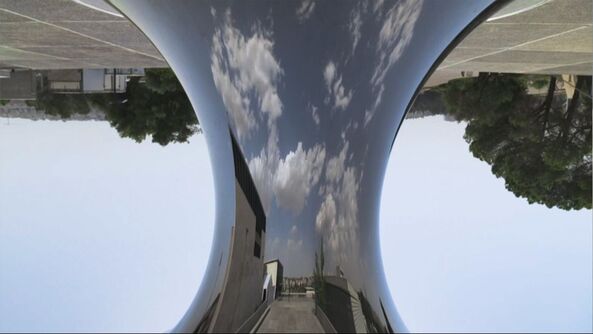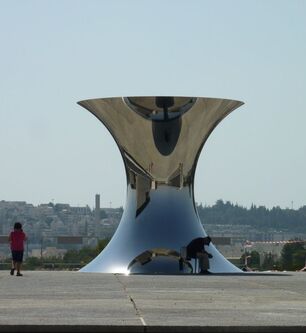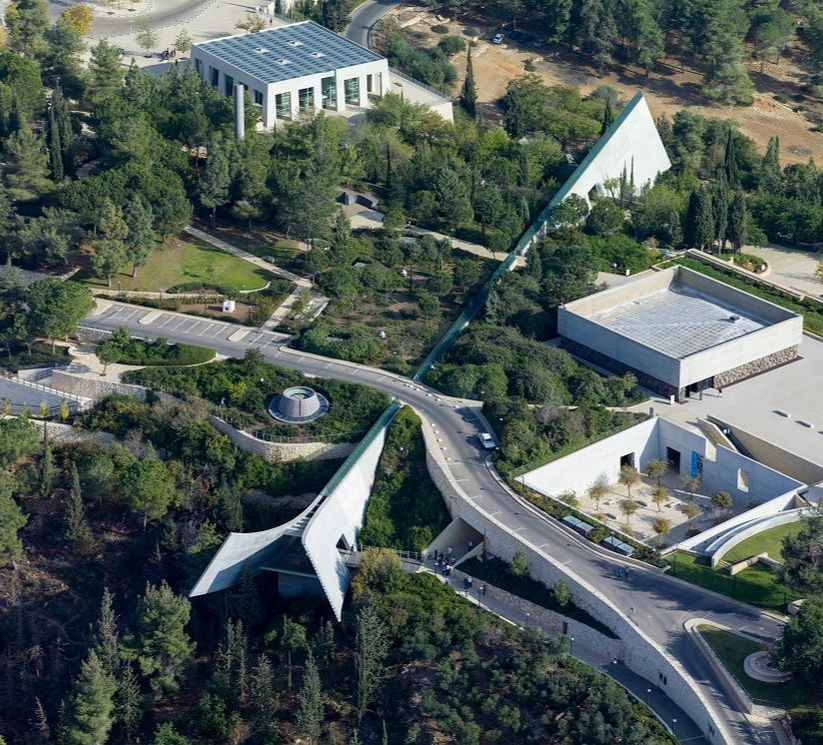Psi
Menu
JERUSALEM
Below is a presentation of the artwork and locations in Jerusalem,
in order of appearance in the film.
Below is a presentation of the artwork and locations in Jerusalem,
in order of appearance in the film.
|
|
For the Tree of the Field is Man's Life
Zadok Ben-David
Zadok Ben-David
Zadok Ben-David's sculpture "For the Tree of the Field is Man's Life" was installed in 2003 at the Yad Vashem museum in Jerusalem. The name is taken originally from Deuteronomy 20:19 but in contemporary Israeli culture is linked to the poem by Natan Zach. It is made up of approximately 600 hand-sculpted figures of men, women and children, each different from the others. Ben-David said: "Yad Vashem approached me to make something commemorating the Partisans, the people who fought the Nazis from the forests, and I singled out one tree, which seen from one side looks like an ordinary tree, but when you come closer you start to see hundreds of figures - from the ground to the branches - of men, women and children, and that's where it started."
|
Zadok Ben-David (born 1949) is an Israeli, London-based, award-winning artist. He graduated in advanced sculpture from St. Martin’s School of Art in London and taught at the same institution from 1977-1982. His works are held in the collections of public and private institutions in Europe, East Asia, the United States, Israel and Australia.
Yad Vashem
Har Hazikaron, P.O.B. 3477 Jerusalem 9103401 Israel |
Blumfield Garden Fountain
|
Blumfield Gardens is one of the largest parks in Jerusalem (approximately 17 acres). The municipality purchased the Nikephoria area in which the park is located from the Greek Orthodox Church in order to safeguard its preservation as public open space. The park's design by Ulrik Plessner was intended to be an organic extension of the open spaces surrounding the Old City to the east. The garden incorporates the family tomb of King Herod and the remains of an ancient aqueduct. To the north side of the park, near the King David Hotel., is a large, canopy-like fountain, seen in the film.
|
Church of the Holy Sepulchre
|
The Church of the Holy Sepulchre is a church in the Christian Quarter of the Old City of Jerusalem. The church contains the two holiest sites in Christianity: the site where Jesus of Nazareth was crucified at a place known as "Calvary" or "Golgotha," and Jesus's empty tomb, where he is said to have been buried and resurrected. According to Eusebius of Caesarea, the Roman emperor Hadrian in the 2nd century AD built a temple dedicated to the goddess Venus in order to cover the cave in which Jesus had been buried. Just inside the entrance to the church is the Stone of Anointing which, according to tradition, is the spot where Jesus's body was prepared for burial by Joseph of Arimathea.
|
Stairway to Heaven
Ezra Orion
Ezra Orion
While the original name of the sculpture was simply "Stairway", it was given the name "Jacob's Ladder" by the local residents, who interpreted the diagonal upside down movement of the white sculpture as the movement of angels ascending and descending the ladder in the biblical dream described in the story of Jacob. It was installed in the Giv'at Mordechai neighborhood of Jerusalem in 1979. It displays a 57-foot stairway rising into the sky. Many people, especially children, have yearned to climb and reach the top. However, the upside down shape of the stairs makes it impossible to climb.
|
Ezra Orion (1934- 2015) was an Israeli sculptor. In 1952, he attended the Bezalel Academy of Art and Design in Jerusalem as well as the Central Saint Martins College of Art and Design and the Royal College of Art in London. Orion describes his geologic structures as “launching pads” for the mind. In the late 1980s, he created an "Intergalactic Sculpture" by sending a Laser beam to the Milky Way under the auspices of the Israeli Space Agency and the Israel Museum.
|
Shakhal St 1-11, Giv'at Mordechai
Jerusalem, Israel |
Inversion
Roxy Paine
Roxy Paine
"Inversion" was created in 2008 by American artist Roxy Paine and installed as part of the Israel Museum's Billy Rose Art Garden in January 2011. It was acquired through a gift by Jill and Jay H. Bernstein to the American Friends of the Israel Museum. It is 42-feet tall and hand-constructed out of over 7,000 metal plate, pipe, and rod stainless steel elements. "Inversion" was the first of Paine’s sculptures from his Dendroid series in which the dendritic form appears upside down, all of its weight resting on the smallest and finest limbs.
|
Roxy Paine (born 1966) is an American artist based in New York City. He has said of Inversion: “It could be read as being emblematic of, and a monument to, how much we have altered the natural world. It could also be read as a meditation on humanity’s need to distill every entity into its component parts and then restructure them.” Paine’s long interest in the juxtaposition of nature and industry has brought form to an extensive body of work. Through his Replicants (exacting simulations of fungi and plant-life), his art-making machines, and his large-scale stainless steel Dendroids, Paine explores the collision between the man-made world that we can control and nature’s world that we cannot.
|
Israel Museum
Derech Ruppin, Jerusalem, Israel |
Dome of the Rock
|
The Dome of the Rock (Arabic: قبة الصخرة Qubbat al-Sakhrah, Hebrew: כיפת הסלע Kippat ha-Sela) is a shrine located on the Temple Mount in the Old City of Jerusalem. It was initially completed in 691 CE at the order of Umayyad Caliph Abd al-Malik during the Second Fitna, built on the site of the Roman temple of Jupiter Capitolinus, which had in turn been built on the site of Herod's Temple, destroyed during the Roman Siege of Jerusalem in 70 CE. The original dome collapsed in 1016 and was rebuilt in 1021. The Dome of the Rock is in its core one of the oldest works of Islamic architecture. The site's significance stems in part from religious traditions regarding the rock, known as the Foundation Stone, at its heart, which bears great significance for Jews and Muslims as the site of Abraham's attempted sacrifice of his son. It has been called "Jerusalem's most recognizable landmark," and it is a UNESCO World Heritage Site.
|
Chords Bridge
Santiago Calatrava
Santiago Calatrava
|
Located at the West entrance of the city of Jerusalem, the Chords Bridge (Hebrew: גשר המיתרים, Gesher HaMeitarim), also called the Bridge of Strings, is a side-spar cable-stayed bridge in Jerusalem which was inaugurated on June 25, 2008. The structure was designed by the Spanish architect and engineer Santiago Calatrava and is meant both for use by the Jerusalem Light Rail as well as pedestrians. The bridge consists of a single 118-metre high mast supporting the roadway via 66 steel cables counterbalancing a 160-metre span with lengths of cables, making it the tallest structure in Jerusalem at the time of its completion.
Santiago Calatrava Valls (born 1951) is a Spanish neofuturistic architect, structural engineer, sculptor and painter. Calatrava has defined his style as bridging the division between structural engineering and architecture. Among his other works, he has designed the World Trade Center Transportation Hub and the new World Trade Center in New York. |
Center of the World
David Breuer-Weil
David Breuer-Weil
"Center of the World" was dedicated in 2013 in Teddy Kollek Park in the heart of Jerusalem. Based on a Renaissance map by Heinrich Bünting showing Jerusalem at the center of three continents, this monumental work made of steel, stone and light is an innovative affirmation of the status of Jerusalem as the spiritual center of the world, combining ancient and contemporary materials, two and three dimensions, light and dark, and interior and exterior spaces. Seas and oceans are suggested by the cut-away sections between continents which at night become patches of light as the work is internally lit.
|
David Breuer-Weil (born 1965) is an artist based in London. He studied at Central Saint Martins College of Art and Design, and his work has been exhibited worldwide. On "Center of the World," Breuer-Weil commented: ‘I was inspired by the idea of using a five-hundred year old map to do something very contemporary. Many sculptures are housed in museums only accessible during the day but I wanted to do something that brought out the beauty of the Jerusalem nights as well as the radiant days. The dome-like structure resonates with the many other domes in the City which gives the work an immediate sense of belonging in Jerusalem.’
|
Turning the World Upside Down
Sir Anish Kapoor
Sir Anish Kapoor
In 2010, "Turning the World Upside Down" by artist Anish Kapoor was commissioned and installed at the Israel Museum in Jerusalem. The large hourglass-shaped object is located on the Ida Crown plaza, at the top of the Carter promenade just before the upper entrance to the museum’s main building. Built out of highly polished stainless steel, it stands at a height of 5 meters. It reflects and reverses the Jerusalem sky and the museum's landscape: the top half reflects the ground, while the lower half reflects the skyline. Visually, the reversed reflections of the two halves create a contrast of color and subject matter.
|
Sir Anish Kapoor, CBE RA (born 12 March 1954) is a British-Indian sculptor. Born in Bombay, Kapoor has lived and worked in London since the early 1970s when he moved to study art, first at the Hornsey College of Art and later at the Chelsea School of Art and Design. Since 1995, he has worked with the highly reflective surface of polished stainless steel. These works are mirror-like, reflecting or distorting the viewer and surroundings. Over the course of the following decade Kapoor's sculptures ventured into more ambitious manipulations of form and space.
|
Israel Museum
Derech Ruppin, Jerusalem, Israel |
The Western Wall / Kotel
|
The Western Wall or Kotel (Hebrew: הַכֹּתֶל הַמַּעֲרָבִי) is an ancient limestone wall in the Old City of Jerusalem. It is considered holy due to its connection to the Temple Mount, which is just above/behind it. Over half the wall's total height, including its 17 courses located below street level, dates from the end of the Second Temple period, and is commonly believed to have been built around 19 BCE by Herod the Great, although recent excavations indicate that the work was not finished by the time Herod died in 4 BCE. The term Western Wall is mostly used for the section traditionally used by Jews for prayer, and it has also been called the "Wailing Wall" referring to the practice of Jews praying at the site over the destruction of the Temples. In a broader sense, the Western Wall can refer to the entire 488 meter-long (1,601 ft.) retaining wall on the western side of the Temple Mount. The classic portion now faces a large plaza in the Jewish Quarter, near the southwestern corner of the Temple Mount, while the rest of the wall is concealed behind structures in the Muslim Quarter.
|
Homage to Jerusalem
Alexander Calder
Alexander Calder
"Homage to Jerusalem" was the last great outdoor sculpture created by Alexander Calder (1898-1976), one of the most acclaimed and influential sculptors of our time. Calder's outdoor sculptures, which were created on a grand scale from bolted sheet steel, grace public plazas in cities throughout the world. "Homage to Jerusalem" is a red-painted, multi-arched sculpture that frames the Judean Hills. He conceived the work on his visit to Jerusalem in 1975 and, after returning to his studio in Sache, France, chose the precise location and angle at which he wanted the sculpture erected. The sculpture was completed after the artist's death in 1976 and installed in 1977 on Mount Herzl. This and many other sculptures were part of The Jerusalem Foundation's plan to improve the quality of life, increase beauty in the city and raise cultural awareness in Jerusalem by placing outdoor sculptures at various prominent locations.
|
Alexander Calder (1898 –1976) was an American sculptor known as the originator of the mobile, a type of moving sculpture made with delicately balanced or suspended shapes that move in response to touch or air currents. Calder’s monumental stationary sculptures are called stabiles. In 1987, the Calder Foundation was established by Calder's family. The foundation "is dedicated to collecting, exhibiting, preserving, and interpreting the art and archives of Alexander Calder and is charged with an unmatched collection of his works."
¤Other Calder works in Ψ: "Four Arches" in Los Angeles and "The Red Spider" in Paris. |
Mount Herzl, Jerusalem
|
Yad Vashem
Yad Vashem is Israel's official memorial to the victims of the Holocaust. Established in 1953, Yad Vashem is on the western slope of Mount Herzl. The memorial consists of a 44 acre complex. Replacing the previous 30-year-old exhibition, the new Yad Vashem museum was designed by Israeli-Canadian architect Moshde Safdie and is the culmination of a $100 million decade-long expansion project. Shaped like a triangular concrete prism that cuts through the landscape, illuminated by a 200-meter long skylight, it consists of a long corridor connected to 10 exhibition halls, each dedicated to a different chapter of the Holocaust. The triangular form of the structure was chosen to support the pressure of the earth while bringing in daylight from above through a 200 meter-long glass skylight.
|
Moshe Safdie, CC, FAIA (born 1938) is an Israeli/Canadian/American architect, urban designer, educator, theorist, and author. His works are known for their dramatic curves, arrays of geometric patterns, use of windows, and key placement of open and green spaces. He is a self-described modernist. He is most identified with Habitat 67, which paved the way for his international career.
|
Yad Vashem
Har Hazikaron, P.O.B. 3477 Jerusalem 9103401 Israel |
Knesset Menorah
Benno Elkan
Benno Elkan
|
The Knesset Menorah (Hebrew: מנורת הכנסת) is a bronze Menorah 4.30 meters high, 3.5 meters wide, and weighing 4 tons. Designed by Jewish sculptor Benno Elkan, it was presented to the Knesset (the national legislature of Israel) as a gift from the Parliament of the United Kingdom on April 15, 1956 in honor of the eighth anniversary of Israeli independence. It is located at the edge of Gan Havradim (Rose Garden) opposite the Knesset. The Knesset Menorah was modeled after the golden candelabrum that stood in the Temple in Jerusalem. A series of bronze reliefs on the Menorah depict the struggles to survive of the Jewish people.
Benno Elkan OBE (1877 - 1960) was a German-born British sculptor and medalist. He fled Germany in 1933 after the rise of the Nazis and lived in England. His works included tombs, busts, medals and monuments. He was an exhibitor in International Exhibitions in Germany, France, Italy, and England; his works are in many museums in Europe. |
Rothschild Street, Jerusalem
Jerusalem 91950 |
[email protected]
© COPYRIGHT 2022. ALL RIGHTS RESERVED.
© COPYRIGHT 2022. ALL RIGHTS RESERVED.



